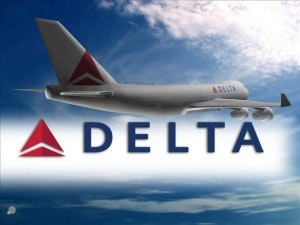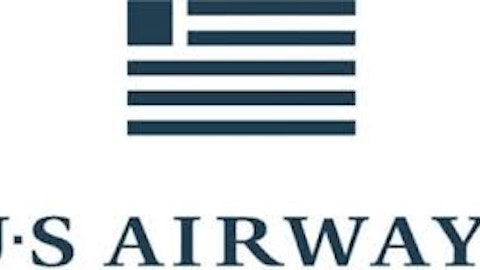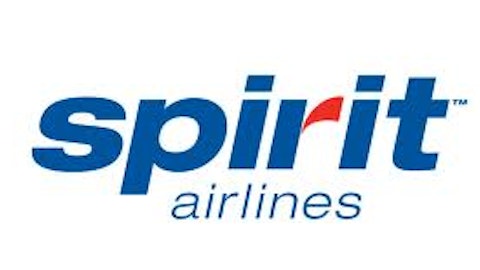
Since the beginning of the year, shares of Delta Air Lines, Inc. (NYSE:DAL) spiked by nearly 60%. Delta Air Lines, Inc. (NYSE:DAL)’s stock wasn’t the only the company that rallied in recent months. Shares of United Continental Holdings Inc (NYSE:UAL) sharply rose by 47%; shares of Southwest Airlines Co. (NYSE:LUV), by 40%.
Economic recovery in the U.S isn’t the only factor that could explain the sharp rise of the leading airline stocks. Let’s examine other factors that could have helped pull up these stocks. More importantly, will this rally last?
Jet fuel and the airlines
The drop in the price of oil may have improved the profitability of leading airline companies: In 2013 (year to date), the price of oil reached an average of $93.90 compared with $102.50 during the same time frame in 2012 – an 8.5% decline.
Moreover, the premium of jet fuel over the price of oil also fell in the past several months, as indicated in the chart below. According to the Energy Information Administration, for a typical airline jet fuel accounts for nearly 30% of its total expenditure. So the drop in oil price and premium of jet fuel may have contributed to a drop in ticket prices and a rise in airline profit margins, even though they remain razor thin.

Source of Data: EIA
The drop in oil prices is reflected in the decline in fuel expenses and average price per gallon. For Delta (opens pdf), the price per gallon fell by 1.2% in the first quarter of 2013 (y-o-y); total fuel expenses fell by 2.7% in Q1 2013 compared to Q1 2012.
Airline travel and freight on the rise
According to the Bureau of Transportation, air travel and freight transportation services increased in the first quarter of 2013 by 0.9% compared to 2012 (y-o-y): the travel business grew by only 0.1%; freight transportation rose by 1.3%.
Leading airline companies have shown a very similar growth rate in terms of revenue: Delta Air Lines, Inc. (NYSE:DAL)’s revenue grew by roughly 1% in the first quarter of 2013 (y-o-y) compared to the same quarter in 2012; Southwest’s revenue rose by 1.4% in the first quarter of 2013; United Continental Holdings Inc (NYSE:UAL)’s net income increased by 2.3% (y-o-y). These leading companies were able to augment their revenue in recent months as they cut their capacity: Delta Air Lines, Inc. (NYSE:DAL)’s capacity was down by 2.5% in Q1 2013 (y-o-y). United Continental also cut its capacity by 4.9% in Q1 2013 compared to the same time last year.
On the other hand, airlines continue to demonstrate very low profit margins: In the first quarter of 2013, Delta Air Lines, Inc. (NYSE:DAL)’s operating profit margin fell to 2.6%; Southwest Airlines Co. (NYSE:LUV)’s profit margin reached 1.7%. In the same quarter in 2012 its profit margin was 0.6%. Conversely, United Continental Holdings Inc (NYSE:UAL) continued to lose money: In the first quarter of 2013, the company’s operating loss was $264 million compared with $271 million in Q1 2012. Because the airline industry is characterized with near perfect competition (and has been so for many years), it’s no surprise that these companies have very small profit margins.
Furthermore, these leading airlines’ unit revenue fell in April: Delta Air Lines, Inc. (NYSE:DAL)’s unit revenue fell by 2%; Southwest Airlines Co. (NYSE:LUV)‘s, by 4% to 5%; United Continental Holdings Inc (NYSE:UAL), by 1%. On the other hand, according to Delta officials, its unit revenue rose by as much as 1% during May.
Sequester aftermath
Many talked about the recent sequester in which the budget cuts that included a reduction in the number of traffic controllers, which resulted in longer travel delays. The Bureau of Transportation also reported a rise in delays. But even though this item was widely covered in the news, it had a small effect on airline companies. If the U.S policymakers decide to extend their budget cuts on traffic controllers in coming years, this might have a longer adverse effect on the airline industry.
The bottom line
The major airlines are moving in the right direction, but I can’t see how, in such a competitive industry, profit margins or revenue are likely to rise by a significant rate anytime soon. Therefore, even though these companies are doing better in improving their operations, I don’t think these actions will be enough to make these companies attractive investments.
The article Is It Time to Consider Investing in the Airlines? originally appeared on Fool.com and is written by Lior Cohen.
Copyright © 1995 – 2013 The Motley Fool, LLC. All rights reserved. The Motley Fool has a disclosure policy.


